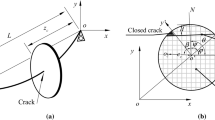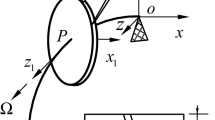Abstract
In this paper, an investigation on the nonlinear vibration, especially on the super-harmonic resonances, in a cracked rotor system is carried out to provide a novel idea for the detection of crack faults in rotor systems. The motion equations of the system are formulated with the consideration of the additional excitation from an inertial environment as well as the forced excitation of the rotor unbalance. By using the harmonic balance method, the analytical solutions of the equations with four orders of harmonic exponents are obtained to analyze the nonlinear response of the system. Then through numerical calculations, the vibration responses affected by system parameters including the inertial excitation, the forced excitation, the crack and damping factors are investigated in detail. The results show that the occurrence of the super-harmonic resonances of the rotor system is due to the interaction between crack breathing and the inertial excitation. Correspondingly, the super-harmonic responses are significantly affected by the inertial excitation and the crack stiffness (or depth). The rotor unbalance, however, does not make apparent effects on the super-harmonic responses. Consequently, the super-harmonic resonances peaks can be viewed as an identification signal of the crack fault due to the application of the inertial excitation. By utilizing the inertial excitation, the super-harmonic response signals in rotor systems with early crack faults can be amplified and detected more easily.
Similar content being viewed by others
References
Chen Y S, Zhang H B. Review and prospect on the research of dynamics of the aero-engine system. Acta Aeronautica et Astronautica Sinica, 2011, 32: 1371–1391
Chen Z J, Zheng J, Zhang S Y. Finite element modeling of heating phenomena of cracks excited by high-intensity ultrasonic pulses. Chin Phys B, 2010, 19: 118104
Wauer J. Dynamics of cracked rotors: Literature survey. Appl Mech Rev, 1990, 43: 13–17
Gasch R. A survey of the dynamic behaviour of a simple rotating shaft with a transverse crack. J Sound Vib, 1993, 160: 313–332
Dimarogonas A. Vibration of cracked structures: A state of the art review. Eng Fract Mech, 1996, 55: 831–857
Pennacchi P, Bachschmid N, Vania A. A model-based identification method of transverse cracks in rotating shafts suitable for industrial machines. Mech Syst Signal Pr, 2006, 20: 2112–2147
Sekhar A S. Model-based identification of two cracks in a rotor system. Mech Syst Signal Pr, 2004, 18: 977–983
Ishida Y, Inoue T. Detection of a rotor crack using a harmonic excitation and nonlinear vibration analysis. J Vib Acoust, 2006, 128: 741–749
Sinou J J. Detection of cracks in rotor based on the 2× and 3× superharmonic frequency components and the crack-unbalance interactions. Commun Nonlinear Sci Numer Simulat, 2008, 13: 2024–2040
AL-Shudeifat M A, Butcher E A, Stern C R. General harmonic balance solution of a cracked rotor-bearing-disk system for harmonic and sub-harmonic analysis: Analytical and experimental approach. Int J Eng Sci, 2010, 48: 921–935
Sekhar A S. On-line rotor fault identification by combined model and signal-based approach. Noise Vib Worldwide, 2004, 35: 16–30
Dong H B, Chen X F, Li B, et al. Rotor crack detection based on high-precision modal parameter identification method and wavelet finite element model. Mech Syst Signal Pr, 2009, 23: 869–883
Ramesh Babu T, Srikanth S, Sekhar A S. Hilbert-Huang transform for detection and monitoring of crack in a transient rotor. Mech Syst Signal Pr, 2008, 22: 905–914
Deng X, Wang Q. Crack detection using spatial measurements and wavelets. Int J Fract, 1998, 91: 23–28
Peng Z K, Chu F L. Application of the wavelet transform in machine condition monitoring and fault diagnostics: a review with bibliography. Mech Syst Signal Pr, 2004, 18: 199–221
Sekhar A S. Detection and monitoring of crack in a coast-down rotor supported on fluid film bearings. Tribol Int, 2004, 37: 279–287
Darpe A K. A novel way to detect transverse surface crack in a rotating shaft. J Sound Vib, 2007, 305: 151–171
Mohammed A A, Neilson R D, Deans W F, et al. Crack detection in a rotating shaft using artificial neural networks and PSD characterization. Meccanica, 2014, 49: 255–266
Zhang C L, Li B, Yang Z B, et al. Crack location identification of rotating rotor systems using operating deflection shape data. Sci China Tech Sci, 2013, 56: 1723–1732
Zhang L, Zhang Y, Liu X Z, et al. Multi-crack imaging using nonclassical nonlinear acoustic method. Chin Phys B, 2014, 23: 104301
Sekhar A S. Multiple cracks effects and identification. Mech Syst Signal Pr, 2008, 22: 845–878
Machorro-Lopez J M, Adams D E, Gomez-Mancilla J C, et al. Identification of damaged shafts using active sensing–Simulation and experimentation. J Sound Vib, 2009, 327: 368–390
Wang R X, Jin Y, Xu M Q. Approach of fault diagnosis based on similarity degree matching distance function. Sci China Tech Sci, 2013, 56: 2709–2720
Chen B Q, Zhang Z S, Zi Y Y, et al. A pseudo wavelet system-based vibration signature extracting method for rotating machinery fault detection. Sci China Tech Sci, 2013, 56: 1294–1306
Zhang X F, Hu N Q, Hu L, et al. Multi-scale bistable stochastic resonance array: A novel weak signal detection method and application in machine fault diagnosis. Sci China Tech Sci, 2013, 56: 2115–2123
Lin F S, Meng G. Study on the dynamics of a rotor in a maneuvering aircraft. J Vib Acoust, 2003, 125: 324–327
Lin F S, Meng G, Eric H. Nonlinear dynamics of a cracked rotor in a maneuvering aircraft. Appl Math Mech-Eng, 2004, 25: 1139–1150
Hou L, Chen Y S, Cao Q J. Nonlinear vibration phenomenon of an aircraft rub-impact rotor system due to hovering flight. Commun Nonlinear Sci Numer Simulat, 2014, 19: 286–297
Hou L, Chen Y S. Analysis of 1/2 sub-harmonic resonance in a maneuvering rotor system. Sci China Tech Sci, 2014, 57: 203–209
Yang Y F, Ren X M, Qin W Y. Study of Nonlinear response of cracked jeffcott rotor in hovering state (in Chinese). J Aero Power, 2007, 22: 1007–1012
Yang Y F, Ren X M, Qin W Y, et al. Analysis on the nonlinear response of cracked rotor in hover flight. Nonlinear Dyn, 2010, 61: 183–192
Duchemin M, Berlioz A, Ferraris G. Dynamic behavior and stability of a rotor under base excitation. J Vib Acoust, 2006, 128: 576–585
Driot N, Lamarque C H, Berlioz A. Theoretical and experimental analysis of a base-excited rotor. J Comput Nonlin Dyn, 2006, 1: 257–263
Doughty S. Response of single degree of freedom mechanisms to base excitation. Mech Mach Theory, 2001, 36: 833–842
Lee A S, Kim B O, Kim Y C. A finite element transient response analysis method of a rotor-bearing system to base shock excitations using the state-space Newmark scheme and comparisons with experiments. J Sound Vib, 2006, 297: 595–615
El-Saeidy F M A, Sticher F. Dynamics of a rigid rotor linear/nonlinear bearings system subject to rotating unbalance and base excitations. J Vib Control, 2010, 16: 403–438
Han Q K, Chu F L. Dynamic response of cracked rotor-bearing system under time-dependent base movements. J Sound Vib, 2013, 332: 6847–6870
Hou L, Chen Y S, Li Z G. Constant-excitation caused response in a class of parametrically excited systems with two degrees of freedom. Acta Phys Sin, 2014, 63: 134501
Xue S M, Cao J Y, Lin J, et al. Influence of fractional order damping on nonlinear dynamics of cracked rotor. J Xi’an Jiaotong Univ, 2012, 46: 76–80
Zhu C, Robb D, Ewins D. The dynamics of a cracked rotor with an active magnetic bearing. J Sound Vib, 2003, 265: 469–487
Author information
Authors and Affiliations
Corresponding author
Rights and permissions
About this article
Cite this article
Hou, L., Chen, Y. Super-harmonic responses analysis for a cracked rotor system considering inertial excitation. Sci. China Technol. Sci. 58, 1924–1934 (2015). https://doi.org/10.1007/s11431-015-5850-z
Received:
Accepted:
Published:
Issue Date:
DOI: https://doi.org/10.1007/s11431-015-5850-z




